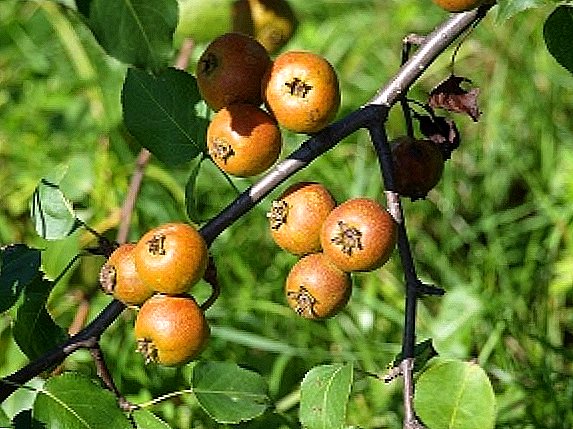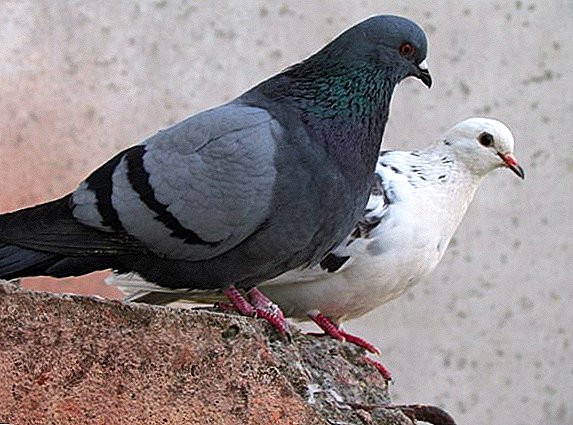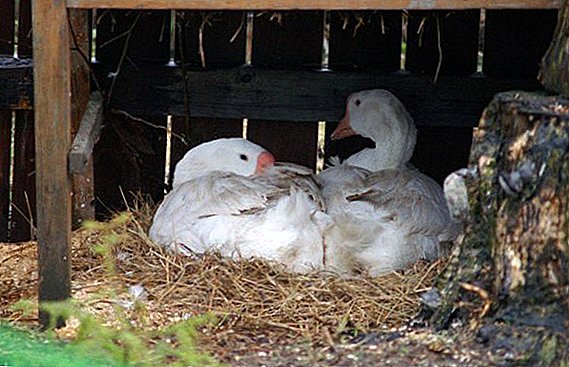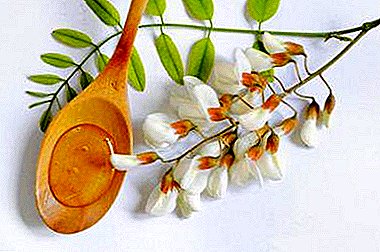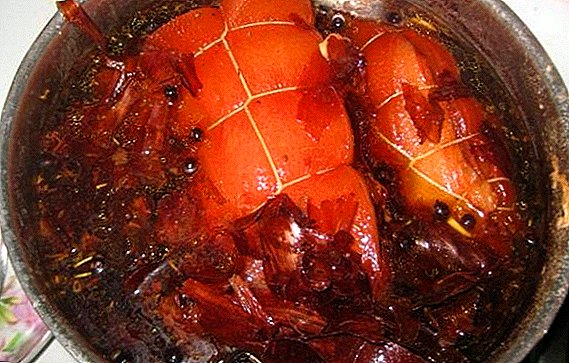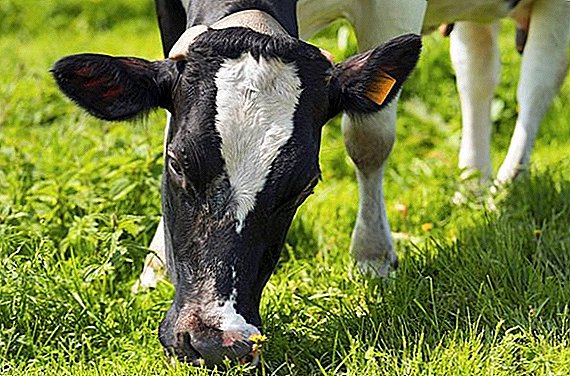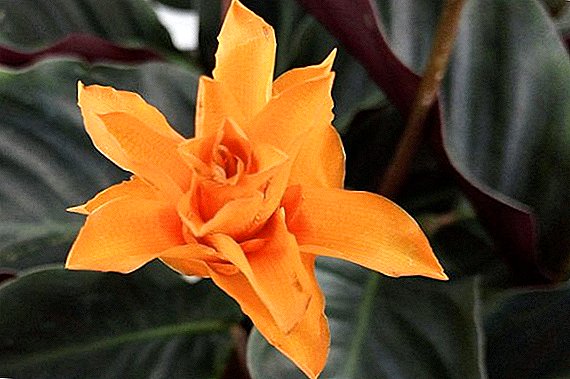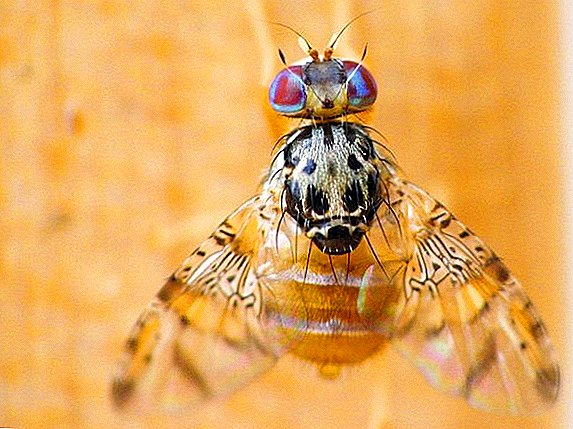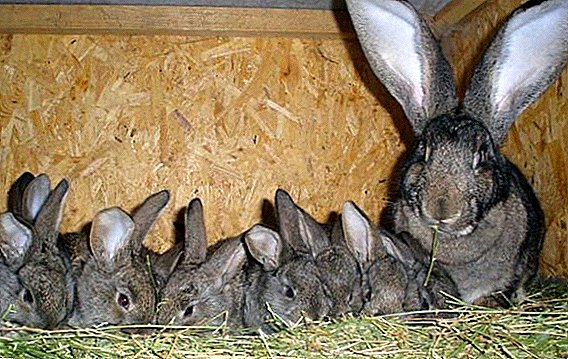 Rabbits are widely known for their fertility. However, such a joyful event for every breeder, like okrol, can be accompanied by a series of troubles and excesses that should be prepared in advance. To breed rabbits bring pleasure and profit, you need to know the features of winter and summer childbirth in a rabbit, as well as the subtleties of feeding the female after childbirth.
Rabbits are widely known for their fertility. However, such a joyful event for every breeder, like okrol, can be accompanied by a series of troubles and excesses that should be prepared in advance. To breed rabbits bring pleasure and profit, you need to know the features of winter and summer childbirth in a rabbit, as well as the subtleties of feeding the female after childbirth.
Breeding rabbits
Of all pets, rabbits are the most prolific. The female is able to bring offspring up to 4-5 times a year, while around 6-9 babies weighing 40-50 g are born.  Of course, the successful result of a circle is preceded by successful mating, which can occur at any time of the year. As a rule, the female is ready to mate every 8-10 days.
Of course, the successful result of a circle is preceded by successful mating, which can occur at any time of the year. As a rule, the female is ready to mate every 8-10 days.
Experts do not advise to hurry with the first mating, because its too early start can lead to a further decrease in animal productivity and the duration of breeding.
Find out when to let the rabbit on the mating and what to do if the rabbits do not mate.
At the same time, very late mating can also have a negative effect, which is manifested in reduced productivity, poor maternal instinct.
The optimal time for the first mating are:
- for the rabbit - 5-6 months;
- for a crawl - 7-8 months.
Also, when determining the readiness of the female to cover, you can be guided by the animal's body weight. For most breeds, the first mating is done when the rabbit weighs 3.5-4 kg.
For reproduction choose only healthy, active animals. It is desirable that the male was slightly smaller than the female. If the rabbit is larger - this can cause problems during childbirth, due to the large size of the rabbit. The duration of the "date" is from two to six hours. 
Features of pregnancy
Sometimes fertilization from the first time may not occur, therefore it is recommended to re-implant the bunny to the male again in 6-7 days. If she runs away, hides, does not let the gentleman to her - the process went well.
Important! To make sure that the pairing has occurred, you should follow the reactions of the animal. The male after the process falls off the female, grunts a little and lies motionless on its side for several minutes.
Pregnancy at the rabbit lasts about one month - 28-31 days, sometimes it can take up to 36 days. The number of offspring in each female varies. The average is 5-7 rabbits. Though cases of birth of only one baby or, on the contrary, as many as 20 cubs are not excluded.
However, the latter variants are extremely undesirable, and such a female is no longer allowed to breeding.
It should be noted that with prolonged pregnancy increases the likelihood of the birth of a small number of rabbits, but the babies are quite large and well developed. With short-term sukroolnosti the number of offspring is much higher, but the degree of development of the rabbit is significantly lower.
Did you know? The most numerous in the entire history of rabbit breeding have become juveniles in 1978 and 1999, when females gave birth to 24 cubs.
During pregnancy, the bunny need to provide good nutrition and increase the amount of feed consumed by about 25-30%. It is important that there is always clean and fresh water in the cage, otherwise its deficiency can lead to various complications during sutry.  Circumference in most cases occurs at night and lasts from 10 minutes to 1 hour. Although the rabbit’s childbirth is carried out without help, the breeder should be on the alert if something goes wrong. At the end of the process of childbirth, the rabbit eats its afterbirth, licks and covers the babies.
Circumference in most cases occurs at night and lasts from 10 minutes to 1 hour. Although the rabbit’s childbirth is carried out without help, the breeder should be on the alert if something goes wrong. At the end of the process of childbirth, the rabbit eats its afterbirth, licks and covers the babies.
Learn more about how long it lasts and how to determine the rabbit suckling.
Behavior rabbit before okrolom
The behavior of the female before giving birth is different from the traditional. If in the normal state the rabbit behaves calmly and quietly, then at the time of approaching the rabbit becomes restless, anxious and even aggressive.
Hereby
Pregnancy rabbit becomes a cause of changes in its behavior.
She is:
- behaves aggressively towards the male: does not admit to herself, can attack or bite, avoids sexual contact with him in every possible way;
- becoming more cautious and shy;
- starts building a nest. The nest arrangement during this pregnancy begins a few days before the intended birth, on the 26-27th day. The female pulls out of fluff, lines it into the nest, hides in a secluded place. At this time, she can behave aggressively and not let the owners to her;
- feeds heavily. The suckling female begins to eat much more, to drink a lot of water, it becomes more demanding to feed.
 A pregnant rabbit is gradually gaining weight, her belly becomes more rounded.
A pregnant rabbit is gradually gaining weight, her belly becomes more rounded.False
In rabbits, there is such a thing as a false pregnancy, when mating has occurred, but fertilization is not, while the animal behaves in the same way as during a real pregnancy:
- reacts aggressively to others;
- does not admit to itself the male;
- begins to build a nest;
- worries and hides from the owner.
To distinguish a false pregnancy from a real one in the early stages is almost impossible. However, if the female starts building the uterine nest quite early, already in the second week, then most likely fertilization has not occurred.
As a rule, this condition lasts about two weeks, while the corpus luteum acts. After that, the rabbit calms down and behaves in the usual way.
Preparation for okrol
Approximately a week before giving birth, it is necessary to carry out a series of activities that will ensure a successful, easy and safe rabbit. First of all, in a cage, you should organize comfortable conditions as close as possible to natural ones. By preparation it is impossible to allow negligence and negligence.  Mandatory activities include:
Mandatory activities include:
- clean and dry bedding material. As a litter, you can take soft hay, straw, sawdust. It is important to check the material for the presence of foreign objects about which the female may be injured;
- calm atmosphere. Pregnant bunnies prefer silence and calmness and react negatively to extraneous noises, so it should be separated from other animals and from excessive noise, when meeting with animals, do not make sharp movements;
- disinfection cells. Experts do not recommend sukrolnuyu rabbit transplanted into a new cage, as this can cause her stress. It is better to carry out the old disinfection using special disinfectants or a solution of potassium permanganate. After processing, the cage must be washed well with clean water;
- twilight. To make the female feel calm and safe, it is recommended to protect her from bright sunlight and to arrange twilight indoors. Since in nature, childbirth takes place at night, such a darkened setting will allow the rabbit to relax and calm down;
- warming It is important to protect the future mother from low temperatures. To do this, you can insulate the cage or install additional heating devices, such as impalers or medical heaters.
Did you know? Rabbits are very clean animals that cope with their physiological needs in the same cage or aviary place, so it is quite possible to teach a pet to use the toilet tray.
And, of course, do not forget about installing the socket.  Its sizes can be different, depending on the breed of rabbits:
Its sizes can be different, depending on the breed of rabbits:
- for small ones: height - 25 cm, width - 25 cm, depth - 35 cm;
- for medium: height - 30 cm, width - 30 cm, depth - 45 cm;
- for large ones: height - 35 cm, width - 35 cm, depth - 55 cm.
The nest is equipped with an additional drinker so that the rabbit does not lack water.
Okrol
Circle - an important event in the life of the breeder, and in the life of the animal. This is how nature works, what happens at night or in the morning. If the outcome is positive, the birth process takes 10-15 minutes. To ensure good conditions during childbirth you need to take care of the organization of the cell, given the seasonality - winter or summer.
In the summer
In the summer, it is very important to arrange the cage in such a way that the rabbit is not stuffy and hot.
For this:
- Do not allow direct sunlight into the cell. Sunlight should fall exclusively in the morning, until 10: 00-11: 00. The rest of the time it can be dangerous for the female and her offspring;
- Care must be taken to ensure that there is not much fluff, hay or straw in the nest and cage. The optimum temperature indicators are +23 degrees. If the temperature is higher, the rabbits will begin to creep away, and as a result, they will die;
- should ensure that the animal sufficient drinking regime. With a deficit of moisture, the rabbit is able to eat newborns;
- you need to organize a full-fledged nutrition based on greensin particular, dandelion, which has a beneficial effect on the formation of milk;
- it is recommended to protect the female from the males. Immediately after the summer rabbit, the rabbit recovers and can be ready for the next mating. In this case, she can stop caring for offspring and feed him. Therefore, it is necessary to install the cage with the rabbits away from the rabbits, at a distance of at least two meters.

In winter
Winter preparation for capping is based on warming the cage and nest with brood, as well as providing the female with quality nutrition with a high content of vitamins and minerals.
Winter childbirth has its advantages, because it is precisely at this time that more healthy, strong and hardy rabbits are born. Frosts contribute to the hardening of young, from which individuals with high productivity will later grow.
Important! The water in the drinker should be at room temperature, so it should be heated before serving.
Winter season has some features:
- for mating choose only experienced, healthy and strong females, characterized by high milkiness;
- organize in a cage comfortable conditions and temperatures of at least +18 degrees. Hot water heaters or lamps can be used for heating. It is also recommended to lay an extra layer of bedding. In case of severe frosts, the walls of the mother liquor should be insulated with foam plastic or sawdust. With an insufficient amount of fluff in it, it is necessary to put cotton wool. It is forbidden to enclose the down of other animals;
- provide good nutrition. Rabbit food should be enriched with vitamins and minerals. The basis of the winter diet should be hay. Besides him, you need to feed the animal: cereals - oats, barley, wheat; root vegetables - carrots, potatoes;
- they count the rabbits, leave as much as the nipples of the female, and even better - one less. The thing is, in the winter, the kids need more nutrition and, if they don’t have enough milk, their chances of survival are drastically reduced;
- provide the female with enough water. After caul it needs a large volume of water, which is associated with intensive milk production.

What to feed after capping
After caulis, mother and her offspring require good nutrition, with a high content of beneficial components.
Little rabbit
During lactation, the animal's body is under heavy stress, so its need for nutrients increases dramatically. Per day, the mammary glands of the female produce about 180 g of milk, and in order to maintain this level, the rabbit should receive 50-70 g of protein.
At the same time, experts recommend changing the diet every 10 days:
- the first 10 days, the female needs 330 g of feed;
- from the 10th to the 20th day - 440 g;
- from 21st to 30th - 560 g;
- from the 31st day before weaning babies - up to 700
As feed, it is preferable to use:
- in summer: greens - alfalfa, clover, forbs; cereals - oats, wheat, barley, corn;
- in winter: potatoes, carrots, hay, silage, bean hay, bran, cake.
 It is recommended to feed the female with hanks, which include: oats - 60%, alfalfa hay - 30-40%, and supplements - 10%. In the menu, bunnies gradually enter sour and dried milk. We must not forget about the inclusion in the diet of special minerals, the lack of which adversely affects the formation of milk.
It is recommended to feed the female with hanks, which include: oats - 60%, alfalfa hay - 30-40%, and supplements - 10%. In the menu, bunnies gradually enter sour and dried milk. We must not forget about the inclusion in the diet of special minerals, the lack of which adversely affects the formation of milk.Baby rabbits
It is especially important to ensure that the rabbit has enough milk. If they sleep peacefully in the mother liquor, do not crawl away, do not squeak, then they are full. If the kids are squealing, their skin is wrinkled, then the food is not enough for them.
Then baby rabbits can be planted to another female. For this, the female is removed from the cage, the babies are cleaned of the old fluff, laid between the other rabbits and covered with new fluff.
Important! When depositing babies to a new mother, you need to take into account that they were approximately the same age and size as the other cubs.
If jigging for any reason cannot be done, then baby rabbits must be fed artificially. As a feed, use special dairy mixes or diluted condensed milk. It is prohibited to use cow's milk for feeding babies. Meals are given with a syringe, once a day for 15-30 g.  Starting from the 25th day of life, rabbits can be transferred to food, because the rabbit stops feeding babies with milk due to the cessation of its production.
Starting from the 25th day of life, rabbits can be transferred to food, because the rabbit stops feeding babies with milk due to the cessation of its production.
Possible problems with the rabbit
During the roundabout, as well as after it, breeders may face some problems with the behavior of the female.
Scatters baby rabbits
Immediately after circulating, the female can throw her babies and throw them around the cage.
One of the most common reasons for such behavior are:
- recovery of sexual desire. Already on the second day after giving birth, the female can enter a state of hunting, during which she becomes irritable, aggressive, capable of a careless attitude towards the offspring;
- development of mastitis. In some animals, nipples may become deeper and mastitis may appear. Unpleasant sensations do not give the rabbit to fully feed the babies, and she avoids the lactation process in every possible way;
- no nest If the conditions for the dog were uncomfortable, the female may throw the rabbits out of the nest. Sometimes she does not have time to build the queen herself, and his absence forces her to scatter the babies in the cage in an attempt to build a nest;
- stress, irritability. Loud sounds, a change of scenery, a strange smell - factors that can cause stress in animals. Becoming easily excitable and nervous, the female refuses to feed the offspring and scatters it.
 Often, young mothers after the first childbirth refuse babies, but in most cases this problem disappears in the future.
Often, young mothers after the first childbirth refuse babies, but in most cases this problem disappears in the future.Eats little rabbits
Some breeders are faced with the fact that the rabbit eats newborn rabbits. In fact, rabbits are herbivores, so eating babies can be explained primarily by the lack of nutrients in the diet of the animal and water. Access to fresh water should be permanent.
The bunny rabbit is able to bite its offspring. This is due to severe childbirth or pain in the nipples during lactation. In such cases, you should carefully examine the female and, if necessary, provide her with medical assistance.
Trampling rabbits
Once the cease is over, the rabbit is able to behave inadequately, in particular, to trample down rabbits.
The reasons for this are different:
- nervous exhaustion, stress caused by too strong sounds, extraneous smells, rude behavior of the breeder;
- low temperatures: lack of heat forces the animal to stomp the babies and look for more comfortable places in the cage;
- poor nutrition and lack of water, which lead to the fact that the mother begins to ignore cubs or even trample down;
- loss of maternal instinct: when the animal recovers sex, it stops feeding rabbits, often scatters them or tramples. In this case, you need to plant the female to the male. After satisfying her needs, she will calm down and return to her maternal duties.

Frequently asked Questions
Beginner krolikovodov may have a lot of questions relating to breeding and about the animals. The answers to the most common ones are given below.
When can a rabbit happen after a moment
Physiologically, the rabbit is ready for mating the very next day after it is around. However, you should not practice fast pairing, as the animal's body will quickly weaken, deplete, and the maternal instinct will gradually fade away.
The optimal period for the "new relationship" is the 25-26th day after birth, when the female stops producing milk.
Important! A case in the winter time is spent during the day, in the summer - in the morning or in the evening.
When you can score after a moment
As a rule, bunny rabbits begin to decrease their productive qualities after 6-7th round. Its milkiness indicators worsen, mammary glands atrophy, progeny survival sharply decreases. Keep it further impractical.  After the rabbit’s milk production process is over, on about the 25th – 26th day after drinking it can be given for slaughter.
After the rabbit’s milk production process is over, on about the 25th – 26th day after drinking it can be given for slaughter.
Often, due to poor maternal instinct, several failures and closures, inadequate behavior after childbirth, and high morbidity, the female is culled from the herd and allowed "to meat" ahead of time.
Is a double pregnancy possible for a rabbit
Female rabbits have a unique anatomy of the genital organs - the double uterus, so in rare cases they may have a double pregnancy, in which embryos of different ages and from different males develop.
This phenomenon may be due to two reasons:
- joint content in the cage of females and males;
- re-fertilization of the rabbit during the control mating.
In any case, such a double pregnancy is undesirable because:
- it dramatically depletes the body, leads to serious health problems;
- may cause the death of the offspring, since the breeder will not be carried out the necessary training for capping.
 In order to achieve good productive offspring of rabbits, special attention should be paid to the process of mating animals and okolu.
In order to achieve good productive offspring of rabbits, special attention should be paid to the process of mating animals and okolu.Creating comfortable, favorable conditions in both cases, as well as selecting only healthy and active producers, will allow you to grow resilient animals, to make their breeding a profitable and profitable business.


